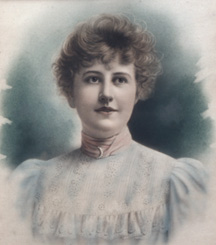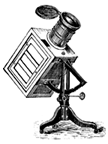 |

an article by Jack Wilgus,
Professor of Photography
Maryland Institute, College of Art
|

Portrait of D.A. Woodward from a carte-de-visite,
the Ross J. Kelbaugh collection |
|
|
This article first appeared in Forays, a cross-disciplinary
review published by the Liberal Arts Division of the Maryland Institute,
College of Art, Spring 1996
© Jack Wilgus, 1996

When I came to the Maryland Institute to teach photography
in the late 1960s I was told that the Institute had been teaching photography
for about a decade. In 1976 while researching the Institute for an exhibition
on stereo photography in the Maryland Historical Society Library I was surprised
to discover references to the teaching of photography in the 19th century.
This led me to search further for information on what seemed to be a little
understood aspect of the Institute's history.
The Maryland Institute was established in 1826 as the Maryland Institute
for the Promotion of Mechanical Arts. It was patterned on the Franklin Institute
of Philadelphia which had been organized in 1824. The first permanent home
of the Institute was the Athenaeum at the corner of Lexington and St. Paul
streets in Baltimore. Here it conducted scientific courses and general lectures
and established a fine library. The Institute continued at this location
until February 7, 1835 when the Athenaeum and all the Institute's property
were destroyed by fire. Sixteen years later in 1851 reorganization was completed
and a new home for the Maryland Institute was erected on Market Place at
Baltimore Street and Marsh Market.
The Market Place building became the home of the school in 1852. Its great
Exhibition Hall, said to be the largest clear space in America could seat
four thousand people. In this great hall the Maryland Institute held an annual
Exhibition of the Mechanical and Fine Arts and awarded medals in Painting,
Drawing, Sculpture, Printmaking, and Photography. The catalogs of the Maryland
Institute Exhibition list in detail the exhibitors and awards given. The
daguerreotypist Charles Fontayne and William Southgate Porter gained fame
when they exhibited an eight whole-plate panorama of Cincinnati at the Franklin
Institute, the Maryland Institute, and the Great Exhibition in London. The
great hall was not only an artistic and cultural center but also the site
of the national conventions of political parties. Four presidential candidates
including Franklin Pierce and Millard Fillmore were nominated in the hall.
In 1852 the newly reorganized and revitalized Maryland Institute engaged
an Instructor of Drawing, David Acheson Woodward. Woodward was born in
Philadelphia in 1823 and moved with his family to Cincinnati, Ohio were
he showed a strong interest in Art. He opened portrait painting studios
in
Cincinnati and then Philadelphia. He studied painting at the Pennsylvania
Academy and traveled and painted in the United States until 1847 when
he moved to Baltimore. He established a painting studio on the
corner of
North and Fayette streets. In 1851 he married Josephine Laty, the daughter
of a Baltimore shipbuilder. They had five sons and two daughters.
In 1853 Woodward was elected Principle of the Drawing Department at the Institute
and continued in that position until 1860 when he was elected by the board
to be the leader in reorganizing the school. The result was a new School
of Art and Design of which he was chosen Principal. He held that position
until about 1879. The Maryland Institute's Twenty-Ninth Annual Report of
April 1877 speaks candidly of financial and enrollment problems. The Annual
Exhibition was not held, salaries were reduced, departmental appropriations
were reduced, and some departments were discontinued. The report states "...great
depression still exists in all branches of Commercial and Mechanical
industry...". |
Cover illustrations from Maryland Institute Schottisch, 19th century
sheet music, showing the exterior of the Market Place home of the
Institute.
(from the Wilgus collection) 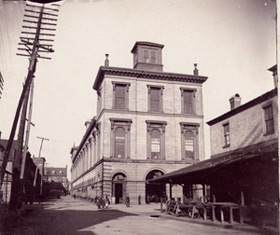
This undated photograph shows the back of the Market
Place home of the Institute before the 1904 fire.
(from the Wilgus collection)

An Annual Exhibition at Maryland Institute in the interior of the
Market Place building. (from a William Chase negative in the
Ross J. Kelbaugh Collection)
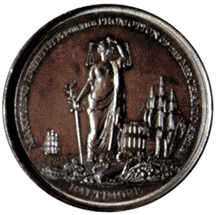
A medal awarded for improvement in drawing in 1854
(from the Wilgus collection) |
| Woodward continues to be listed at the Maryland Institute in
Wood's Baltimore City Directory until 1879. Thereafter he is listed as
an artist with a studio at 74 N. Charles and later 99 N. Charles. No further
mention is made of Woodward in the annual reports of the Institute in the
1880s. Professor Woodward was associated with the Institute for twenty-seven
years. For nineteen of those years he was Principal of the Schools of Art
and Design. His tenure was a period of innovation, technological advancement,
and the development of a pioneering curriculum in the teaching of photography.
In 1857 Woodward patented the first widely successful photographic enlarging
camera. He continued to make improvements to his solar camera in a series
of patent renewals in the 1860s and 1870s. He became internationally recognized
for his invention and in 1876 he was given an award at the Philadelphia
Centennial Exposition. In the 1878 book How to Paint Photographs in
our collection there is an ad for the Improved Solar Cameras by D.A. Woodward,
Maryland Institute, Baltimore, Md.
 |
An advertisement for Woodward's Solar Cameras from the 1878 book How
to Paint Photographs showing a medal awarded at the 1876 Centennial
Exhibition.
(from the Wilgus collection) |
 |
|
| These cameras were usually mounted on a studio roof and were designed
to turn to follow the sun. They were large, heavy devices that used condensers
to focus the light from the sun and a copying lens that projected a small
negative onto a large sheet of sensitized photographic paper or canvas. The
solar camera came in two sizes, half plate with nine inch condenser, and
quarter plate with a five inch condenser. Woodward as a portrait painter
was interested in making enlarged copies of photographs on canvas to paint
over. Using this camera he could print life-sized portraits (18"X22") from
a half plate negative in about forty-five minutes. In 1859 Woodward went
to Europe to publicize his invention. While there he demonstrated the solar
camera for Antoine Claudet in London. Claudet said it was "...one of the
most important improvements introduced into the art of photography." Claudet
helped in its successful introduction in Europe in 1860. The 1876 Maryland
Institute Annual Report mentions the commissioning of a Woodward painting
of the late Johns Hopkins. It states "...the portrait -- and elegant life-size
-- now adorns the main entrance hall."
Baltimore photographer David Bachrach claims to have made over two-thousand
photo portraits using the solar camera during this period. In an
article
"Mayall's Life-Size Portrait of George Peabody" in History of Photography,
October-December 1985 noted historian Larry Schaaf describes a portrait
now in the Peabody Institute of Johns Hopkins University. It is a
portrait enlarged
from a carte de visite by photographer Mayall in 1866, enlarged 30
to 40 times using a Woodward solar enlarger. The final enlargement
was painted
over by A. Armoult. This is an important example of the technique
since much of Woodward's work was destroyed in the Baltimore fire
of 1904.
Many solar enlargments, often with so much overpained that little photographic detail is left, were made at the end of the 19th century through the early 20th century. They are also called crayon portraits. |
A painted solar enlargement from a photographer's sampler - also called a "Crayon Portrait"
(from the Wilgus collection) |
As the Principal of the Schools of Art and Design Professor Woodward was
a pioneer in the field of formal photographic education. His strong interest
in technology and the art of photography are reflected in the inclusion of
photography in the curriculum of the Institute during his tenure. Day school
courses included "Tinting and Coloring Photographs in Water and Oil and Indian
Ink" and "Photography, including the use of the various kinds of Cameras
and Apparatus used in the business." In 1876 the tuition fee for Photography
was Females -- $15.00 and Males -- $20.00 while the fee for Oil Painting
was Females -- $8.00 and Males -- $10.00. The Maryland Institute had one
of the first formal photographic programs under Woodward's direction. Such
programs were very rare in the 19th century. When Woodward left the Institute
in 1879 all photographic courses disappeared from the curriculum. This could
have been caused by the removal of Woodward's influence or by the effect
of budget cutting in tough times since the photography classes were more
expensive than painting. With the end of Woodward's era photography courses
did not reappear at the Institute till the middle of the 20th century. |

On February 7, 1904, the anniversary of the 1835 fire, the Market Place home
of the Maryland Institute was destroyed in the Great Baltimore Fire. The
Great Hall, the fine library, and Woodward's life-size portrait of Johns
Hopkins were now gone. The spirit of the Maryland Institute survived and
classes resumed in temporary quarters two days after the fire. Through an
appropriation by the Maryland legislature, a gift from Andrew Carnegie, and
donated land from Michael Jenkins the Maryland Institute built a new permanent
home at 1300 Mount Royal Avenue. Construction began in October 1905 and the
first class was held in October 1907. The present Main Building was dedicated
in 1908.
The lower level of the main building has housed the Photography Department
since the mid-20th century. In a tribute to his contribution to photography
the exhibition space in the department was called the Woodward Gallery
until 2009.
I feel that we should offer special thanks to David Woodward for his pioneering
efforts in photographic education and his technological advancement of
photography.
|

The ruins of the Maryland Institute Market Place building after the Great
Baltimore Fire of February 7th-9th, 1904
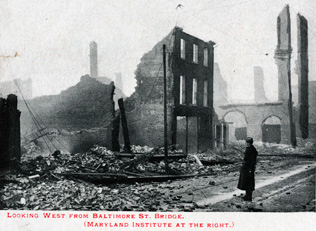
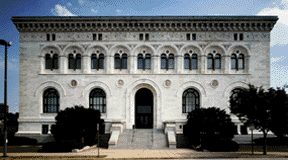
The Maryland Institute, College of Art main building at 1300 Mount Royal
Avenue (photo by Jack Wilgus) |
 |
An advertising card for Woodward's Solar Camera
(from the Wilgus collection) |
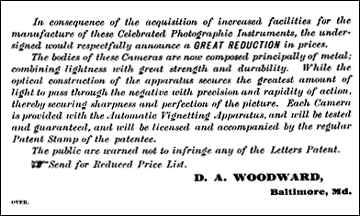 |
The back of the Woodward advertising card above |
Sources
19th Century Maryland Institute Annual Reports and Exhibition catalogs
(The Maryland Historical Society Library)
Biographical Cyclopedia of Representative Men of Maryland and the District
of Columbia,
Baltimore National Biographical Publishing Co., 1879 (Maryland Room -- Enoch
Pratt Free Library)
The Daguerreotype in America, Beaumont Newhall, New York Graphic Society,
1968
Dedication, Maryland Institute, Address by Mr. John M. Carter, President
of the Institute, 1908
The History of Photography, Beaumont Newhall, Museum of Modern Art, 1964
How to Paint Photographs, George B. Ayres, Appleton & Company, 1878
"Mayall's :Life-Size Portrait of George Peabody", Larry J. Schaaf, History
of Photography quarterly, October – December 1985
Photography In America, William Welling, Crowell Company, 1978
Thanks to:
Ross Kelbaugh
Tom Beck
Larry Schaaf
Beverly Wilgus
Contact me at
studio@brightbytes.com
Return to Bright Bytes Studio
Updated: 8/2014








